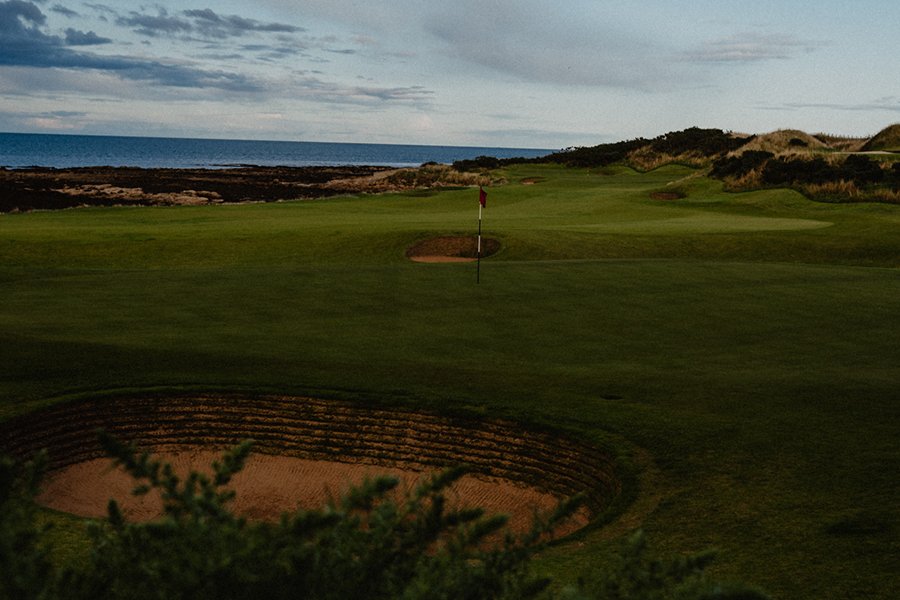Playing Kingsbarns
There are golf holes which you’ve played in the past that lodge themselves in your mind. You go over your choices, your lies, the way you read the putt… probably the putts. You play them over and over again, agonisingly trying to work out what you should have done to make par. It’s rarely a hole where you made birdie, or better. It’s unlikely to be one of the holes at your home course because playing this particularly memorable hole was special: it was a trip away with your friends and so much more was at stake. You may have played this hole just once, or have been fortunate enough to play if often. Yet it’s always the hole where you’d gladly have swapped your ineffective 4-iron for hindsight. You know how you really should have plotted your way to the green, and how all the clues were there in front of you. The distant horizon of dark, white-tipped churning sea grinding away at the rough, torn edges of the course? The wind whipping up the foam and firing it over the green. Birds flying backwards. It was all there.
That hole, for me, is the Stroke Index 6, 185 yards off the whites, par-3 ‘Rocky Ness’ at Kingsbarns. It’s possibly one of the most scenic golf holes ever to have been designed in partnership with nature, and with the right shot from the tee can provide immense amounts of pleasure. With hints of Pebble Beach, it sits on a low finger of land reaching out into the sea, water in front of you and water beyond and a relatively narrow green running left to right. Once the ball is sailing past the trees on your left the wind catches it and takes it on a journey of discovery, which for me has always ended up being the beach. Not the far beach, the nearer one. I think the best I have ever managed here is a bogey-4, and off the beach that felt quite special. And it always makes you want to come back and try your hand at it again.
Having said that, anywhere at Kingsbarns would entice you to return. The gentle drive through the golden wheat and barley fields of East Fife gives no indication of what lies ahead, and the entrance to the course is supremely understated; a small, brown tourist sign points to a gap in a low stone wall, ushering you down an avenue between fields, beech hedges and trees where only the 10mph signs indicate you’re heading somewhere that’s not on the main road. Turning a final corner brings your first glimpse of the sea, a distant flag pole and a flag, rippling proudly above the Clubhouse. Past the multi-discipline and very long driving range lies the car park, the 1st tee off left, the 10th tee to the right, the comfortable Clubhouse and a vista that sets the pulse racing.
The fact that the course has the front and back nine starting near the Clubhouse can be useful for larger outings, but it doesn’t mean that the card is split geographically. Generally, the holes lie parallel to each other on this relatively narrow strip of land, but skilful routing takes the player three quarters of the length of the estate on each nine holes. Using the drop in elevation provided by the 10,000 year-old raised beach, a common feature of links courses seen from Royal Dornoch all the way down to West Kilbride, you find yourself either hugging the coastline or gazing down on other holes, as well as distant greens that seem to hover above the dark blue sea.
The loop from 12-15 is spectacular. Its vista opens in front of you as you emerge from the small forest, re-born from your round so far and already expecting the best. The hooked sweep of the bay sets up the play for the long 12th hole, ‘Orrdeal’, a monster par-5 that’s over 600 yards off the tips in the trees. There’s more room than at first appears, particularly for the second shot as the fairway balloons to the right… my natural fade being accommodated perfectly and now slightly opening up the long, narrow green which sits above the very close beach. It’s a beautiful golf hole, and the view looking back from the green will have featured in a thousand or more photobooks of memorable trips. And yes, just in the distance, on the edge of everyone’s photo, lies the 15th.
Holes 13 and 14 take the higher road back north, climbing white shell paths between banks of yellow-tipped gorse to reach a stunning par-3 protected by deep bunkers and a steep slope on three sides. Next, a gentle par-4 that should cause no problems with its generous fairway protected by the raised beach down the fader’s right. Dropping down from the green and around the trees brings me back to the magnificent 15th, the sea relentlessly crashing feet below the tee and ahead the fluttering red flag on the promontory green. From here there’s sea in front, there’s sea behind (and the magnificent coastline of Carnoustie), sea to the right… the crunching sound of pebbles and rocks rolling back and forth on the small, steep beach ahead. The wind whips normally across from the left, and the arc of the small bay is perfectly aligned to this prevailing wind. There’s so much more green to play with here than you think, but the pseudo-pro in us all wants that magical shot to talk about to their friends. And when the pin is placed on the extreme right, it’s begging you to take that chance. All you need is a smooth swing… no shaping (as if), no lifting to give it extra help, no 110% with the higher club.
Just one smooth swing to bring you back to Kingsbarns to play it all again.




